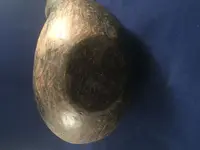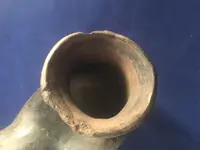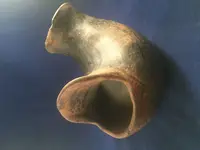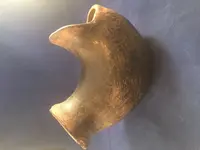You are using an out of date browser. It may not display this or other websites correctly.
You should upgrade or use an alternative browser.
You should upgrade or use an alternative browser.
Please Help!!! Pre-Columbian, Native American Pottery or Neither
- Thread starter Reeves
- Start date
Old Pueblo
Bronze Member
It looks like it could be old. I have a similar piece from here in AZ, but Im not sure of the age.
Sheperdess
Hero Member
- Joined
- Jan 20, 2013
- Messages
- 729
- Reaction score
- 1,224
- Golden Thread
- 0
- Location
- South Dakota
- Detector(s) used
- Teknetics
- Primary Interest:
- All Treasure Hunting
It sorta looks like a horn of an animal. Are you sure it's pottery?
Indian Steve
Silver Member
Looks like some Catawba pottery from NC.
NCPeaches
Silver Member
- Joined
- Mar 24, 2013
- Messages
- 2,880
- Reaction score
- 2,992
- Golden Thread
- 0
- Location
- Western Piedmont North Carolina
- Primary Interest:
- All Treasure Hunting
It does look old and yes it does look like Catawba pottery from NC
joshuaream
Silver Member
- Joined
- Jun 25, 2009
- Messages
- 3,170
- Reaction score
- 4,512
- Golden Thread
- 0
- Location
- Florida & Hong Kong
Reeves, that style of flat bottom isn't terribly common on ancient pottery from the Eastern US. It shows up on some styles (cups/mugs/cylinders) more than others, but it isn't nearly as common here as it is in Central American pottery where it would be more common than not. It became a more common feature on later made for trade pieces that were intended to sit on a table or shelf (a hard flat surface), like much of the Catawba pottery, in the 1800s and later.
I really don't know what it is other than to say I don't think it's normal Mississippian pottery from the eastern part of the US.
I really don't know what it is other than to say I don't think it's normal Mississippian pottery from the eastern part of the US.
Similar threads
- Replies
- 7
- Views
- 505
- Replies
- 6
- Views
- 799
- Suggestion
- Replies
- 0
- Views
- 897
Users who are viewing this thread
Total: 1 (members: 0, guests: 1)








